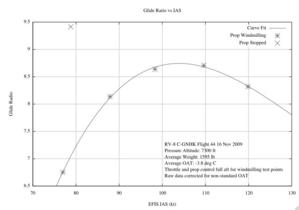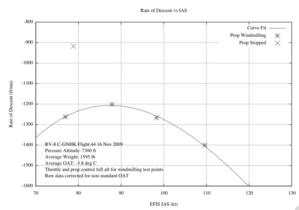I finally found some time to dig into the recorded data from the glide performance testing on Monday. The combination of the Dynon data output logic and the design of my data recording scripts meant that the altitude in the records changed back and forth between pressure altitude and barometric altitude many times a minute (i.e. some were with altimeter setting of 29.92, and some were with 30.13). I came up with an apparently fool proof way to fix that, then crunched the numbers.
 I found that the speed for best glide with the prop windmilling was a bit faster than I had expected. I was expecting it to be about 95 kt at the test weight, but it looks like it is closer to 104 kt. It would probably be closer to 110 kt at gross weight. The glide ratio looks to be about 8.75:1 at the speed for best glide, but I’ll put a value of 8.5:1 in the POH.
I found that the speed for best glide with the prop windmilling was a bit faster than I had expected. I was expecting it to be about 95 kt at the test weight, but it looks like it is closer to 104 kt. It would probably be closer to 110 kt at gross weight. The glide ratio looks to be about 8.75:1 at the speed for best glide, but I’ll put a value of 8.5:1 in the POH.
With the prop stopped, at 80 kt, the glide ratio was about 9.4:1 vs about 7:1 with the prop windmilling at the same speed, which is a significant increase in glide performance. But, given that it is so hard to get the prop to stop turning (I needed to sit just above the stall with full flaps for about 2 minutes to get it to stop), there is little to be gained by attempting to stop the prop. The altitude lost during the steep glide at low speed at full flap would probably never be made up.
 The speed for minimum rate of descent (i.e. the speed that gives the most time to attempt engine restarts, or to make emergency calls on the radio) is about 88 kt.
The speed for minimum rate of descent (i.e. the speed that gives the most time to attempt engine restarts, or to make emergency calls on the radio) is about 88 kt.
Update - 22 Nov 2009 - I was puzzled by a small difference between the results from analyzing one of the test points by hand vs the results I got from my data analysis script. I finally found a Grade 8 math error in the data analysis script (the average of two values is found by ADDING them and dividing by two, not by SUBTRACTING them). Grr. The good news is that once I fixed the error the calculated glide ratios are slightly higher than before.
Update #2 - 22 Nov 2009 - I was curious how high I would need to be before it made sense to slow to just above the stall with full flap to attempt to stop the prop. I looked at the altitude lost during the two minutes or so that it took for the prop to stop, vs the horizontal distance travelled. On average, by the time the prop has stopped, and the airspeed had been increased back to 80 kt, the aircraft was about 850 ft lower than it would have been if the aircraft had been flown at the speed for best glide, with the prop windmilling. After the prop has stopped, the glide performance would be somewhat better than with the prop windmilling, but it would still take about another 11,500 ft of altitude available before the altitude lost while stopping the prop could be made up. Thus in the vast majority of cases there would be no advantage to attempting to stop the prop on my aircraft. I would need to be at least 15,000 ft above ground before it might possibly make sense to attempt to stop the prop.